Humanitarian Logistics: Supply Chain Analysis of Haiti Earthquake
VerifiedAdded on 2023/04/07
|12
|2078
|80
Report
AI Summary
This report provides a comprehensive analysis of the supply chain response to the 2010 Haiti earthquake, evaluating the effectiveness of different phases including emergency response, restoring, and resolving. It identifies what went well, such as data collection and needs assessment, and what did ...
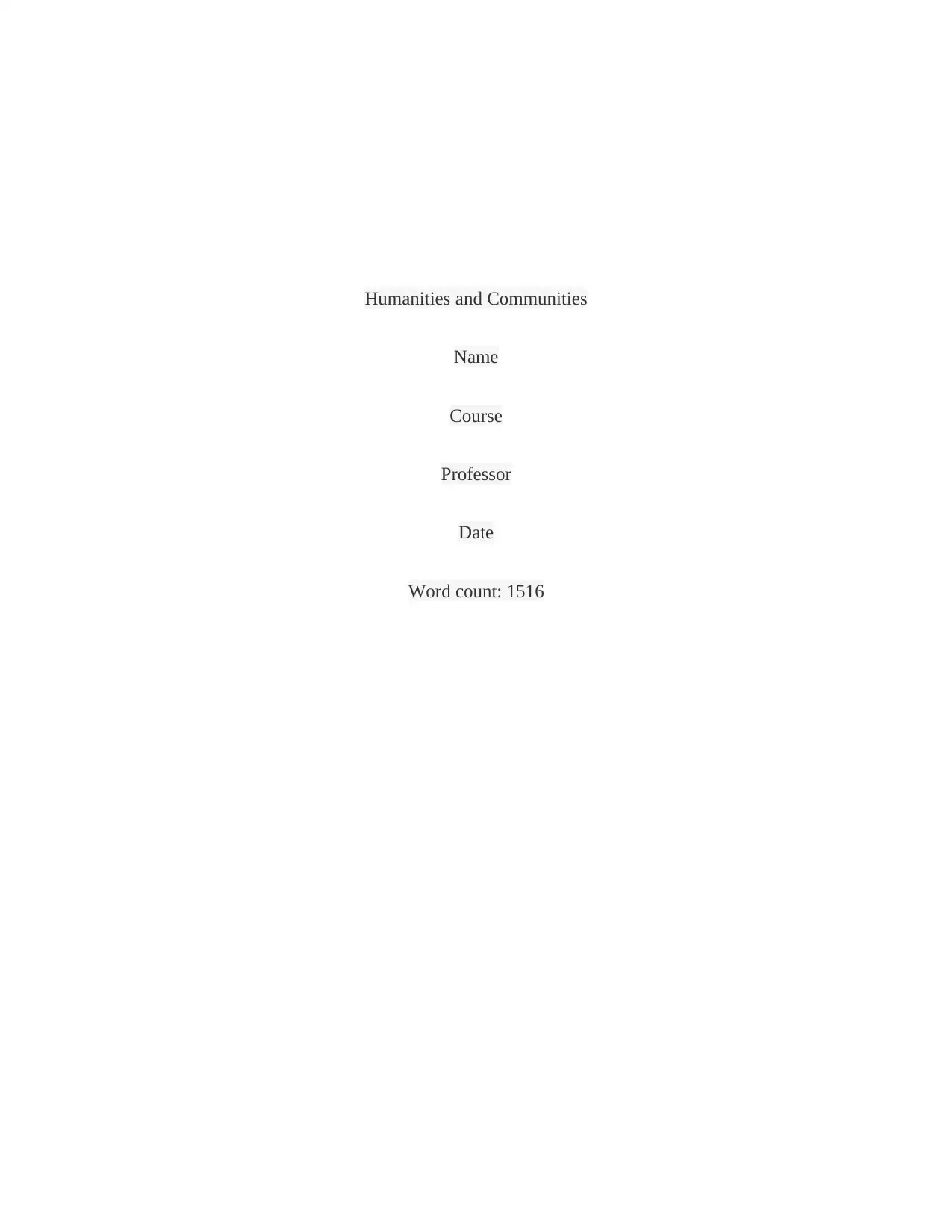
Humanities and Communities
Name
Course
Professor
Date
Word count: 1516
Name
Course
Professor
Date
Word count: 1516
Secure Best Marks with AI Grader
Need help grading? Try our AI Grader for instant feedback on your assignments.
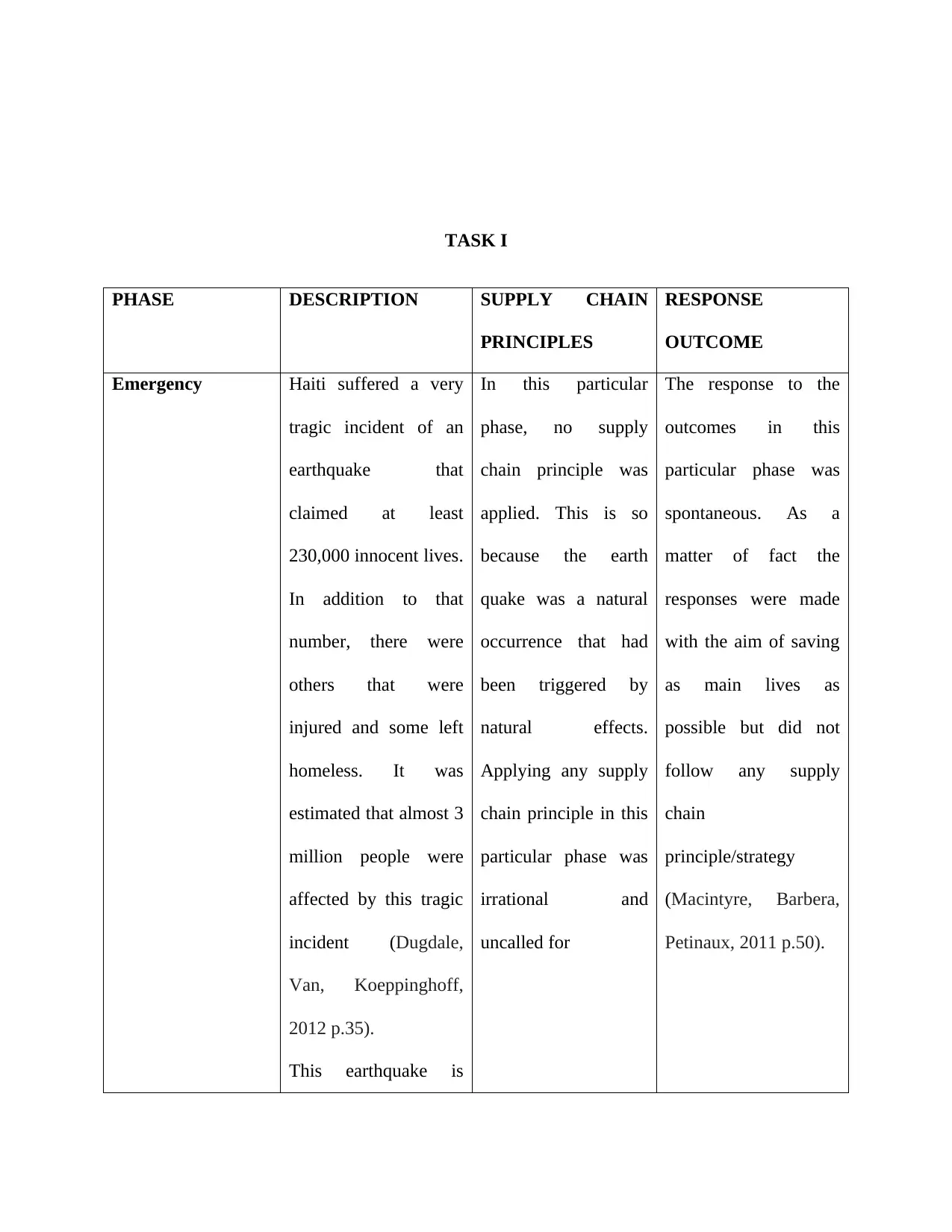
TASK I
PHASE DESCRIPTION SUPPLY CHAIN
PRINCIPLES
RESPONSE
OUTCOME
Emergency Haiti suffered a very
tragic incident of an
earthquake that
claimed at least
230,000 innocent lives.
In addition to that
number, there were
others that were
injured and some left
homeless. It was
estimated that almost 3
million people were
affected by this tragic
incident (Dugdale,
Van, Koeppinghoff,
2012 p.35).
This earthquake is
In this particular
phase, no supply
chain principle was
applied. This is so
because the earth
quake was a natural
occurrence that had
been triggered by
natural effects.
Applying any supply
chain principle in this
particular phase was
irrational and
uncalled for
The response to the
outcomes in this
particular phase was
spontaneous. As a
matter of fact the
responses were made
with the aim of saving
as main lives as
possible but did not
follow any supply
chain
principle/strategy
(Macintyre, Barbera,
Petinaux, 2011 p.50).
PHASE DESCRIPTION SUPPLY CHAIN
PRINCIPLES
RESPONSE
OUTCOME
Emergency Haiti suffered a very
tragic incident of an
earthquake that
claimed at least
230,000 innocent lives.
In addition to that
number, there were
others that were
injured and some left
homeless. It was
estimated that almost 3
million people were
affected by this tragic
incident (Dugdale,
Van, Koeppinghoff,
2012 p.35).
This earthquake is
In this particular
phase, no supply
chain principle was
applied. This is so
because the earth
quake was a natural
occurrence that had
been triggered by
natural effects.
Applying any supply
chain principle in this
particular phase was
irrational and
uncalled for
The response to the
outcomes in this
particular phase was
spontaneous. As a
matter of fact the
responses were made
with the aim of saving
as main lives as
possible but did not
follow any supply
chain
principle/strategy
(Macintyre, Barbera,
Petinaux, 2011 p.50).
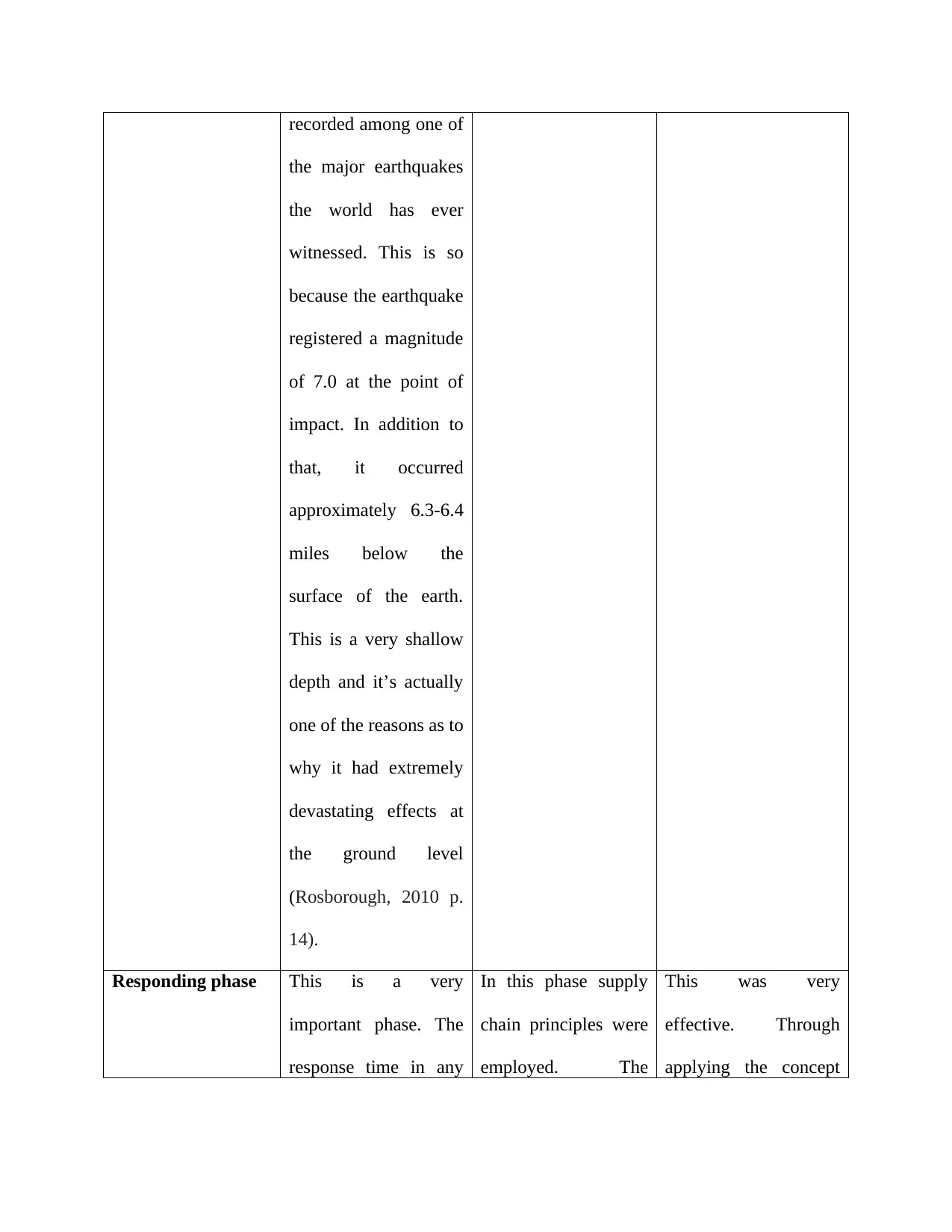
recorded among one of
the major earthquakes
the world has ever
witnessed. This is so
because the earthquake
registered a magnitude
of 7.0 at the point of
impact. In addition to
that, it occurred
approximately 6.3-6.4
miles below the
surface of the earth.
This is a very shallow
depth and it’s actually
one of the reasons as to
why it had extremely
devastating effects at
the ground level
(Rosborough, 2010 p.
14).
Responding phase This is a very
important phase. The
response time in any
In this phase supply
chain principles were
employed. The
This was very
effective. Through
applying the concept
the major earthquakes
the world has ever
witnessed. This is so
because the earthquake
registered a magnitude
of 7.0 at the point of
impact. In addition to
that, it occurred
approximately 6.3-6.4
miles below the
surface of the earth.
This is a very shallow
depth and it’s actually
one of the reasons as to
why it had extremely
devastating effects at
the ground level
(Rosborough, 2010 p.
14).
Responding phase This is a very
important phase. The
response time in any
In this phase supply
chain principles were
employed. The
This was very
effective. Through
applying the concept
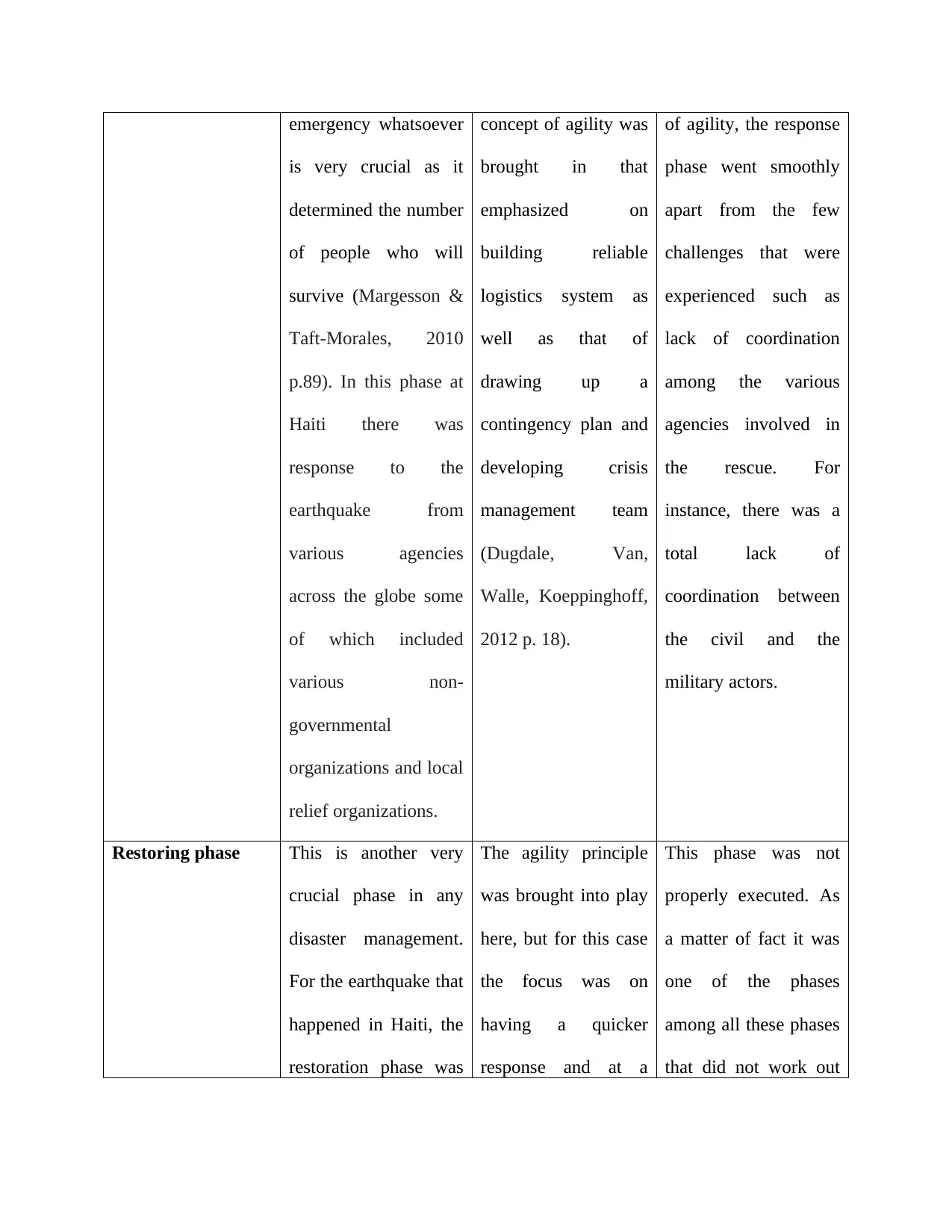
emergency whatsoever
is very crucial as it
determined the number
of people who will
survive (Margesson &
Taft-Morales, 2010
p.89). In this phase at
Haiti there was
response to the
earthquake from
various agencies
across the globe some
of which included
various non-
governmental
organizations and local
relief organizations.
concept of agility was
brought in that
emphasized on
building reliable
logistics system as
well as that of
drawing up a
contingency plan and
developing crisis
management team
(Dugdale, Van,
Walle, Koeppinghoff,
2012 p. 18).
of agility, the response
phase went smoothly
apart from the few
challenges that were
experienced such as
lack of coordination
among the various
agencies involved in
the rescue. For
instance, there was a
total lack of
coordination between
the civil and the
military actors.
Restoring phase This is another very
crucial phase in any
disaster management.
For the earthquake that
happened in Haiti, the
restoration phase was
The agility principle
was brought into play
here, but for this case
the focus was on
having a quicker
response and at a
This phase was not
properly executed. As
a matter of fact it was
one of the phases
among all these phases
that did not work out
is very crucial as it
determined the number
of people who will
survive (Margesson &
Taft-Morales, 2010
p.89). In this phase at
Haiti there was
response to the
earthquake from
various agencies
across the globe some
of which included
various non-
governmental
organizations and local
relief organizations.
concept of agility was
brought in that
emphasized on
building reliable
logistics system as
well as that of
drawing up a
contingency plan and
developing crisis
management team
(Dugdale, Van,
Walle, Koeppinghoff,
2012 p. 18).
of agility, the response
phase went smoothly
apart from the few
challenges that were
experienced such as
lack of coordination
among the various
agencies involved in
the rescue. For
instance, there was a
total lack of
coordination between
the civil and the
military actors.
Restoring phase This is another very
crucial phase in any
disaster management.
For the earthquake that
happened in Haiti, the
restoration phase was
The agility principle
was brought into play
here, but for this case
the focus was on
having a quicker
response and at a
This phase was not
properly executed. As
a matter of fact it was
one of the phases
among all these phases
that did not work out
Secure Best Marks with AI Grader
Need help grading? Try our AI Grader for instant feedback on your assignments.
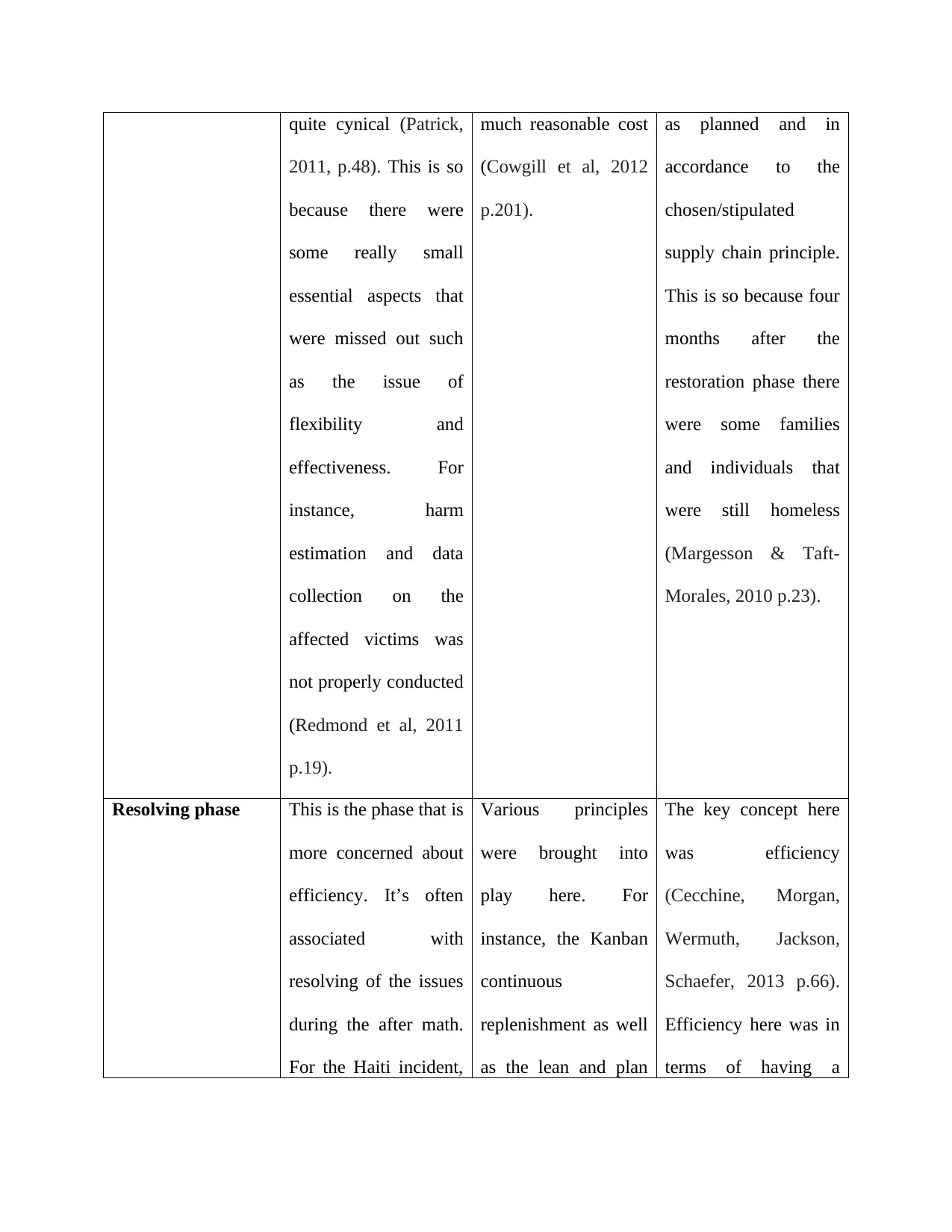
quite cynical (Patrick,
2011, p.48). This is so
because there were
some really small
essential aspects that
were missed out such
as the issue of
flexibility and
effectiveness. For
instance, harm
estimation and data
collection on the
affected victims was
not properly conducted
(Redmond et al, 2011
p.19).
much reasonable cost
(Cowgill et al, 2012
p.201).
as planned and in
accordance to the
chosen/stipulated
supply chain principle.
This is so because four
months after the
restoration phase there
were some families
and individuals that
were still homeless
(Margesson & Taft-
Morales, 2010 p.23).
Resolving phase This is the phase that is
more concerned about
efficiency. It’s often
associated with
resolving of the issues
during the after math.
For the Haiti incident,
Various principles
were brought into
play here. For
instance, the Kanban
continuous
replenishment as well
as the lean and plan
The key concept here
was efficiency
(Cecchine, Morgan,
Wermuth, Jackson,
Schaefer, 2013 p.66).
Efficiency here was in
terms of having a
2011, p.48). This is so
because there were
some really small
essential aspects that
were missed out such
as the issue of
flexibility and
effectiveness. For
instance, harm
estimation and data
collection on the
affected victims was
not properly conducted
(Redmond et al, 2011
p.19).
much reasonable cost
(Cowgill et al, 2012
p.201).
as planned and in
accordance to the
chosen/stipulated
supply chain principle.
This is so because four
months after the
restoration phase there
were some families
and individuals that
were still homeless
(Margesson & Taft-
Morales, 2010 p.23).
Resolving phase This is the phase that is
more concerned about
efficiency. It’s often
associated with
resolving of the issues
during the after math.
For the Haiti incident,
Various principles
were brought into
play here. For
instance, the Kanban
continuous
replenishment as well
as the lean and plan
The key concept here
was efficiency
(Cecchine, Morgan,
Wermuth, Jackson,
Schaefer, 2013 p.66).
Efficiency here was in
terms of having a
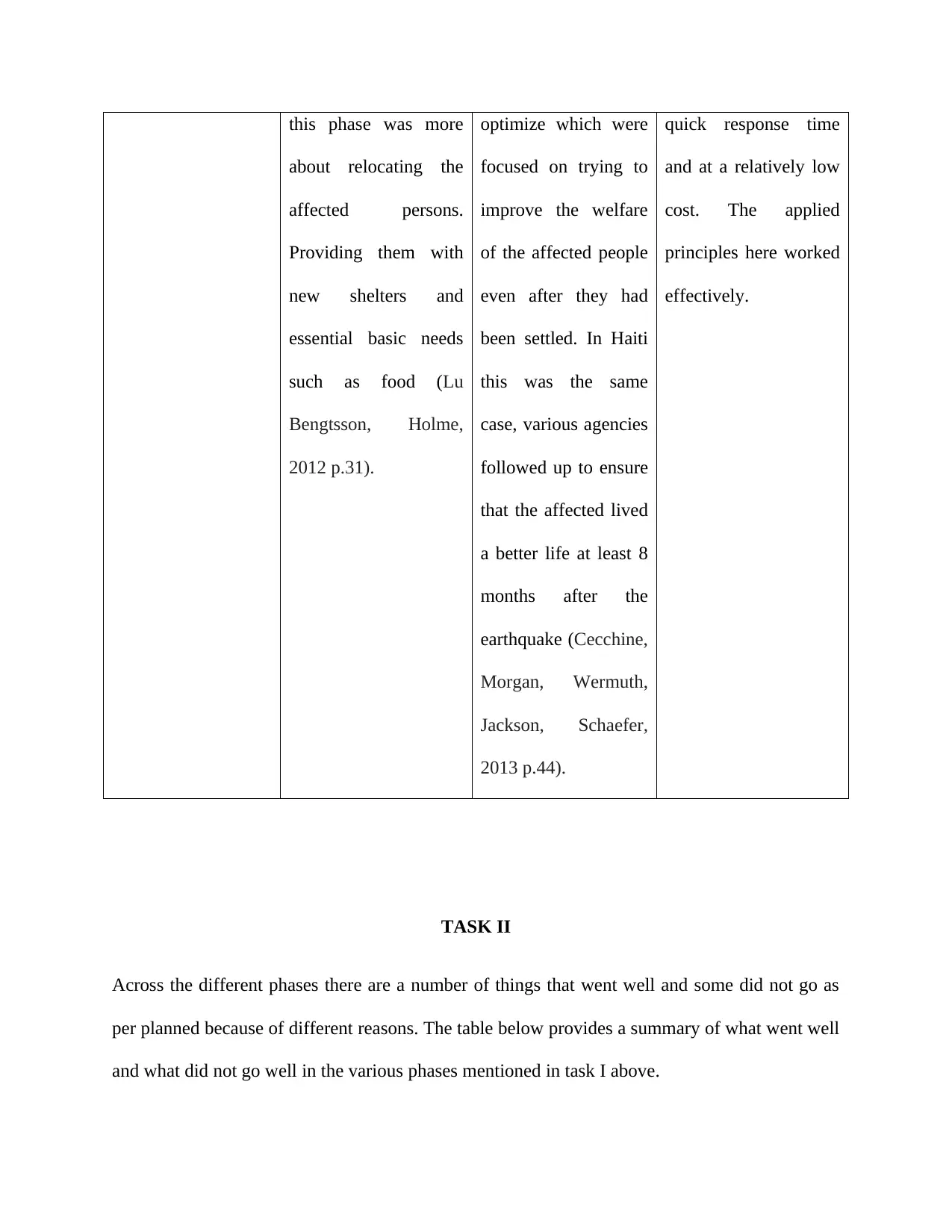
this phase was more
about relocating the
affected persons.
Providing them with
new shelters and
essential basic needs
such as food (Lu
Bengtsson, Holme,
2012 p.31).
optimize which were
focused on trying to
improve the welfare
of the affected people
even after they had
been settled. In Haiti
this was the same
case, various agencies
followed up to ensure
that the affected lived
a better life at least 8
months after the
earthquake (Cecchine,
Morgan, Wermuth,
Jackson, Schaefer,
2013 p.44).
quick response time
and at a relatively low
cost. The applied
principles here worked
effectively.
TASK II
Across the different phases there are a number of things that went well and some did not go as
per planned because of different reasons. The table below provides a summary of what went well
and what did not go well in the various phases mentioned in task I above.
about relocating the
affected persons.
Providing them with
new shelters and
essential basic needs
such as food (Lu
Bengtsson, Holme,
2012 p.31).
optimize which were
focused on trying to
improve the welfare
of the affected people
even after they had
been settled. In Haiti
this was the same
case, various agencies
followed up to ensure
that the affected lived
a better life at least 8
months after the
earthquake (Cecchine,
Morgan, Wermuth,
Jackson, Schaefer,
2013 p.44).
quick response time
and at a relatively low
cost. The applied
principles here worked
effectively.
TASK II
Across the different phases there are a number of things that went well and some did not go as
per planned because of different reasons. The table below provides a summary of what went well
and what did not go well in the various phases mentioned in task I above.
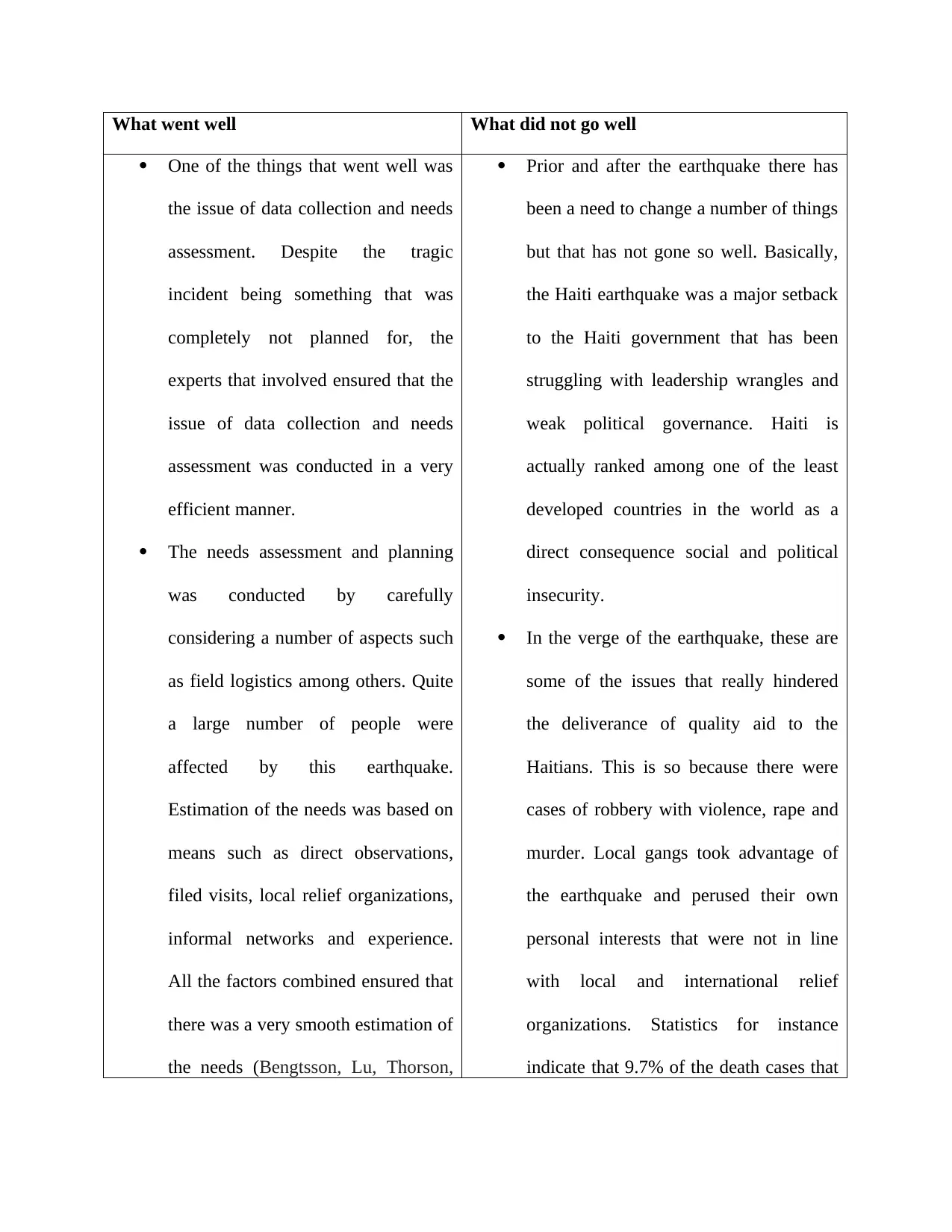
What went well What did not go well
One of the things that went well was
the issue of data collection and needs
assessment. Despite the tragic
incident being something that was
completely not planned for, the
experts that involved ensured that the
issue of data collection and needs
assessment was conducted in a very
efficient manner.
The needs assessment and planning
was conducted by carefully
considering a number of aspects such
as field logistics among others. Quite
a large number of people were
affected by this earthquake.
Estimation of the needs was based on
means such as direct observations,
filed visits, local relief organizations,
informal networks and experience.
All the factors combined ensured that
there was a very smooth estimation of
the needs (Bengtsson, Lu, Thorson,
Prior and after the earthquake there has
been a need to change a number of things
but that has not gone so well. Basically,
the Haiti earthquake was a major setback
to the Haiti government that has been
struggling with leadership wrangles and
weak political governance. Haiti is
actually ranked among one of the least
developed countries in the world as a
direct consequence social and political
insecurity.
In the verge of the earthquake, these are
some of the issues that really hindered
the deliverance of quality aid to the
Haitians. This is so because there were
cases of robbery with violence, rape and
murder. Local gangs took advantage of
the earthquake and perused their own
personal interests that were not in line
with local and international relief
organizations. Statistics for instance
indicate that 9.7% of the death cases that
One of the things that went well was
the issue of data collection and needs
assessment. Despite the tragic
incident being something that was
completely not planned for, the
experts that involved ensured that the
issue of data collection and needs
assessment was conducted in a very
efficient manner.
The needs assessment and planning
was conducted by carefully
considering a number of aspects such
as field logistics among others. Quite
a large number of people were
affected by this earthquake.
Estimation of the needs was based on
means such as direct observations,
filed visits, local relief organizations,
informal networks and experience.
All the factors combined ensured that
there was a very smooth estimation of
the needs (Bengtsson, Lu, Thorson,
Prior and after the earthquake there has
been a need to change a number of things
but that has not gone so well. Basically,
the Haiti earthquake was a major setback
to the Haiti government that has been
struggling with leadership wrangles and
weak political governance. Haiti is
actually ranked among one of the least
developed countries in the world as a
direct consequence social and political
insecurity.
In the verge of the earthquake, these are
some of the issues that really hindered
the deliverance of quality aid to the
Haitians. This is so because there were
cases of robbery with violence, rape and
murder. Local gangs took advantage of
the earthquake and perused their own
personal interests that were not in line
with local and international relief
organizations. Statistics for instance
indicate that 9.7% of the death cases that
Paraphrase This Document
Need a fresh take? Get an instant paraphrase of this document with our AI Paraphraser
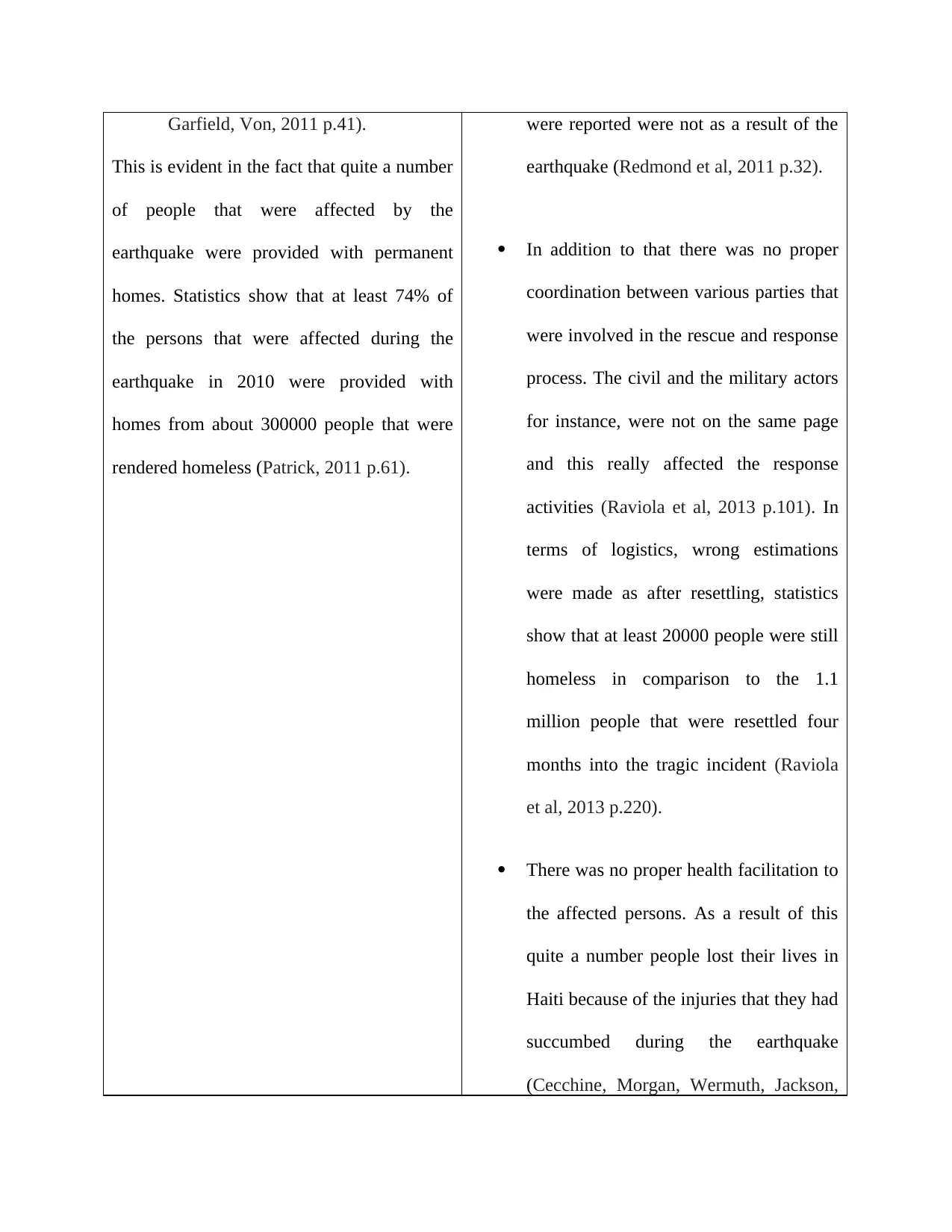
Garfield, Von, 2011 p.41).
This is evident in the fact that quite a number
of people that were affected by the
earthquake were provided with permanent
homes. Statistics show that at least 74% of
the persons that were affected during the
earthquake in 2010 were provided with
homes from about 300000 people that were
rendered homeless (Patrick, 2011 p.61).
were reported were not as a result of the
earthquake (Redmond et al, 2011 p.32).
In addition to that there was no proper
coordination between various parties that
were involved in the rescue and response
process. The civil and the military actors
for instance, were not on the same page
and this really affected the response
activities (Raviola et al, 2013 p.101). In
terms of logistics, wrong estimations
were made as after resettling, statistics
show that at least 20000 people were still
homeless in comparison to the 1.1
million people that were resettled four
months into the tragic incident (Raviola
et al, 2013 p.220).
There was no proper health facilitation to
the affected persons. As a result of this
quite a number people lost their lives in
Haiti because of the injuries that they had
succumbed during the earthquake
(Cecchine, Morgan, Wermuth, Jackson,
This is evident in the fact that quite a number
of people that were affected by the
earthquake were provided with permanent
homes. Statistics show that at least 74% of
the persons that were affected during the
earthquake in 2010 were provided with
homes from about 300000 people that were
rendered homeless (Patrick, 2011 p.61).
were reported were not as a result of the
earthquake (Redmond et al, 2011 p.32).
In addition to that there was no proper
coordination between various parties that
were involved in the rescue and response
process. The civil and the military actors
for instance, were not on the same page
and this really affected the response
activities (Raviola et al, 2013 p.101). In
terms of logistics, wrong estimations
were made as after resettling, statistics
show that at least 20000 people were still
homeless in comparison to the 1.1
million people that were resettled four
months into the tragic incident (Raviola
et al, 2013 p.220).
There was no proper health facilitation to
the affected persons. As a result of this
quite a number people lost their lives in
Haiti because of the injuries that they had
succumbed during the earthquake
(Cecchine, Morgan, Wermuth, Jackson,
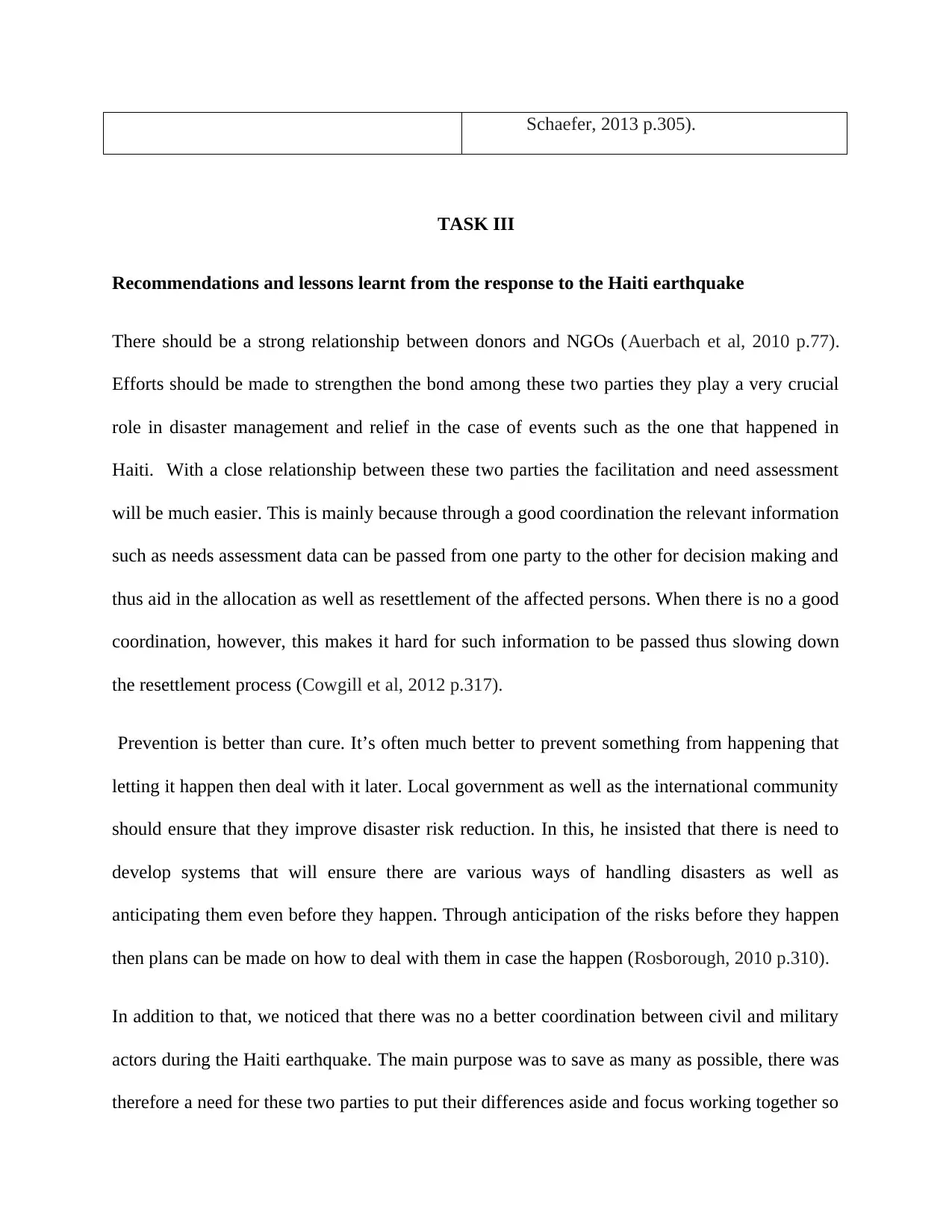
Schaefer, 2013 p.305).
TASK III
Recommendations and lessons learnt from the response to the Haiti earthquake
There should be a strong relationship between donors and NGOs (Auerbach et al, 2010 p.77).
Efforts should be made to strengthen the bond among these two parties they play a very crucial
role in disaster management and relief in the case of events such as the one that happened in
Haiti. With a close relationship between these two parties the facilitation and need assessment
will be much easier. This is mainly because through a good coordination the relevant information
such as needs assessment data can be passed from one party to the other for decision making and
thus aid in the allocation as well as resettlement of the affected persons. When there is no a good
coordination, however, this makes it hard for such information to be passed thus slowing down
the resettlement process (Cowgill et al, 2012 p.317).
Prevention is better than cure. It’s often much better to prevent something from happening that
letting it happen then deal with it later. Local government as well as the international community
should ensure that they improve disaster risk reduction. In this, he insisted that there is need to
develop systems that will ensure there are various ways of handling disasters as well as
anticipating them even before they happen. Through anticipation of the risks before they happen
then plans can be made on how to deal with them in case the happen (Rosborough, 2010 p.310).
In addition to that, we noticed that there was no a better coordination between civil and military
actors during the Haiti earthquake. The main purpose was to save as many as possible, there was
therefore a need for these two parties to put their differences aside and focus working together so
TASK III
Recommendations and lessons learnt from the response to the Haiti earthquake
There should be a strong relationship between donors and NGOs (Auerbach et al, 2010 p.77).
Efforts should be made to strengthen the bond among these two parties they play a very crucial
role in disaster management and relief in the case of events such as the one that happened in
Haiti. With a close relationship between these two parties the facilitation and need assessment
will be much easier. This is mainly because through a good coordination the relevant information
such as needs assessment data can be passed from one party to the other for decision making and
thus aid in the allocation as well as resettlement of the affected persons. When there is no a good
coordination, however, this makes it hard for such information to be passed thus slowing down
the resettlement process (Cowgill et al, 2012 p.317).
Prevention is better than cure. It’s often much better to prevent something from happening that
letting it happen then deal with it later. Local government as well as the international community
should ensure that they improve disaster risk reduction. In this, he insisted that there is need to
develop systems that will ensure there are various ways of handling disasters as well as
anticipating them even before they happen. Through anticipation of the risks before they happen
then plans can be made on how to deal with them in case the happen (Rosborough, 2010 p.310).
In addition to that, we noticed that there was no a better coordination between civil and military
actors during the Haiti earthquake. The main purpose was to save as many as possible, there was
therefore a need for these two parties to put their differences aside and focus working together so
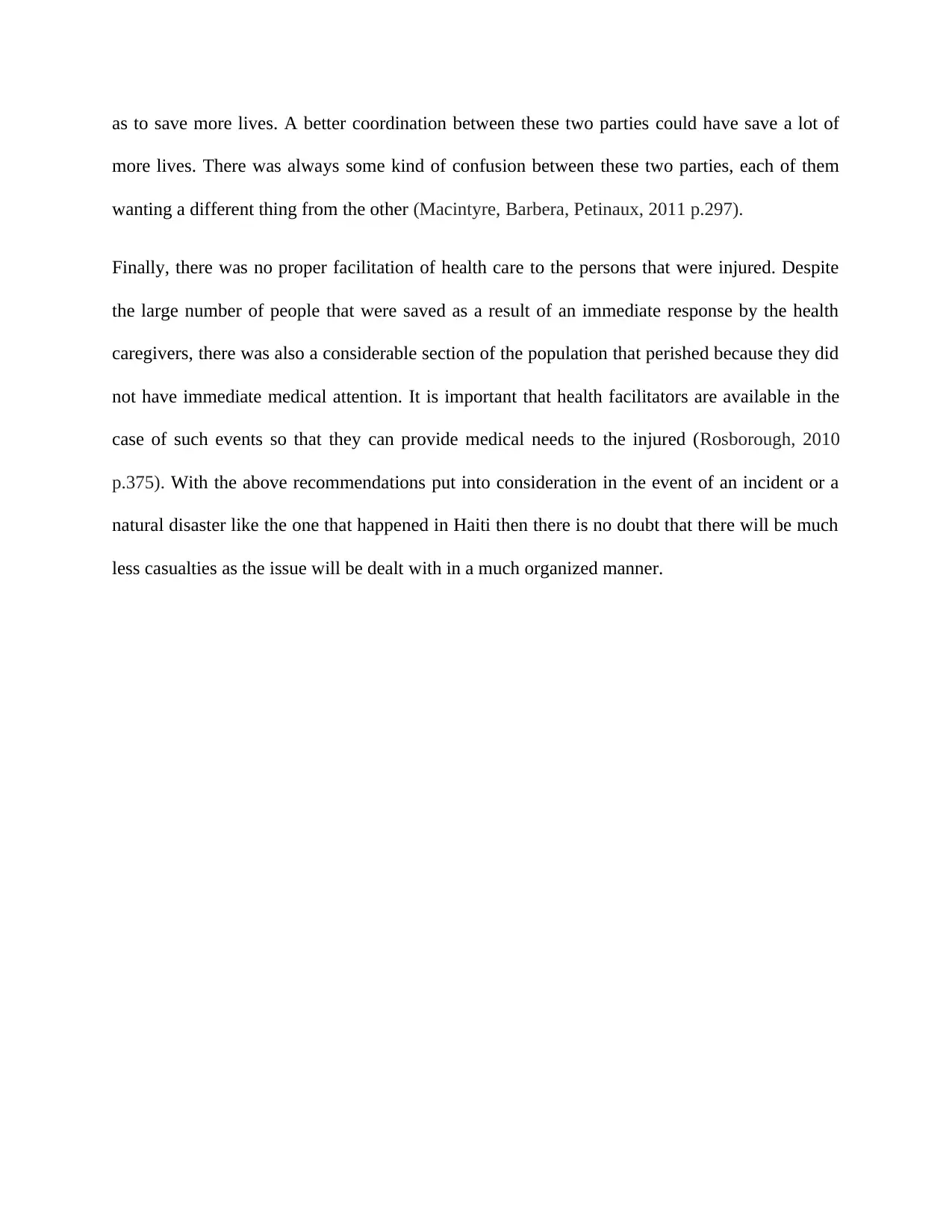
as to save more lives. A better coordination between these two parties could have save a lot of
more lives. There was always some kind of confusion between these two parties, each of them
wanting a different thing from the other (Macintyre, Barbera, Petinaux, 2011 p.297).
Finally, there was no proper facilitation of health care to the persons that were injured. Despite
the large number of people that were saved as a result of an immediate response by the health
caregivers, there was also a considerable section of the population that perished because they did
not have immediate medical attention. It is important that health facilitators are available in the
case of such events so that they can provide medical needs to the injured (Rosborough, 2010
p.375). With the above recommendations put into consideration in the event of an incident or a
natural disaster like the one that happened in Haiti then there is no doubt that there will be much
less casualties as the issue will be dealt with in a much organized manner.
more lives. There was always some kind of confusion between these two parties, each of them
wanting a different thing from the other (Macintyre, Barbera, Petinaux, 2011 p.297).
Finally, there was no proper facilitation of health care to the persons that were injured. Despite
the large number of people that were saved as a result of an immediate response by the health
caregivers, there was also a considerable section of the population that perished because they did
not have immediate medical attention. It is important that health facilitators are available in the
case of such events so that they can provide medical needs to the injured (Rosborough, 2010
p.375). With the above recommendations put into consideration in the event of an incident or a
natural disaster like the one that happened in Haiti then there is no doubt that there will be much
less casualties as the issue will be dealt with in a much organized manner.
Secure Best Marks with AI Grader
Need help grading? Try our AI Grader for instant feedback on your assignments.
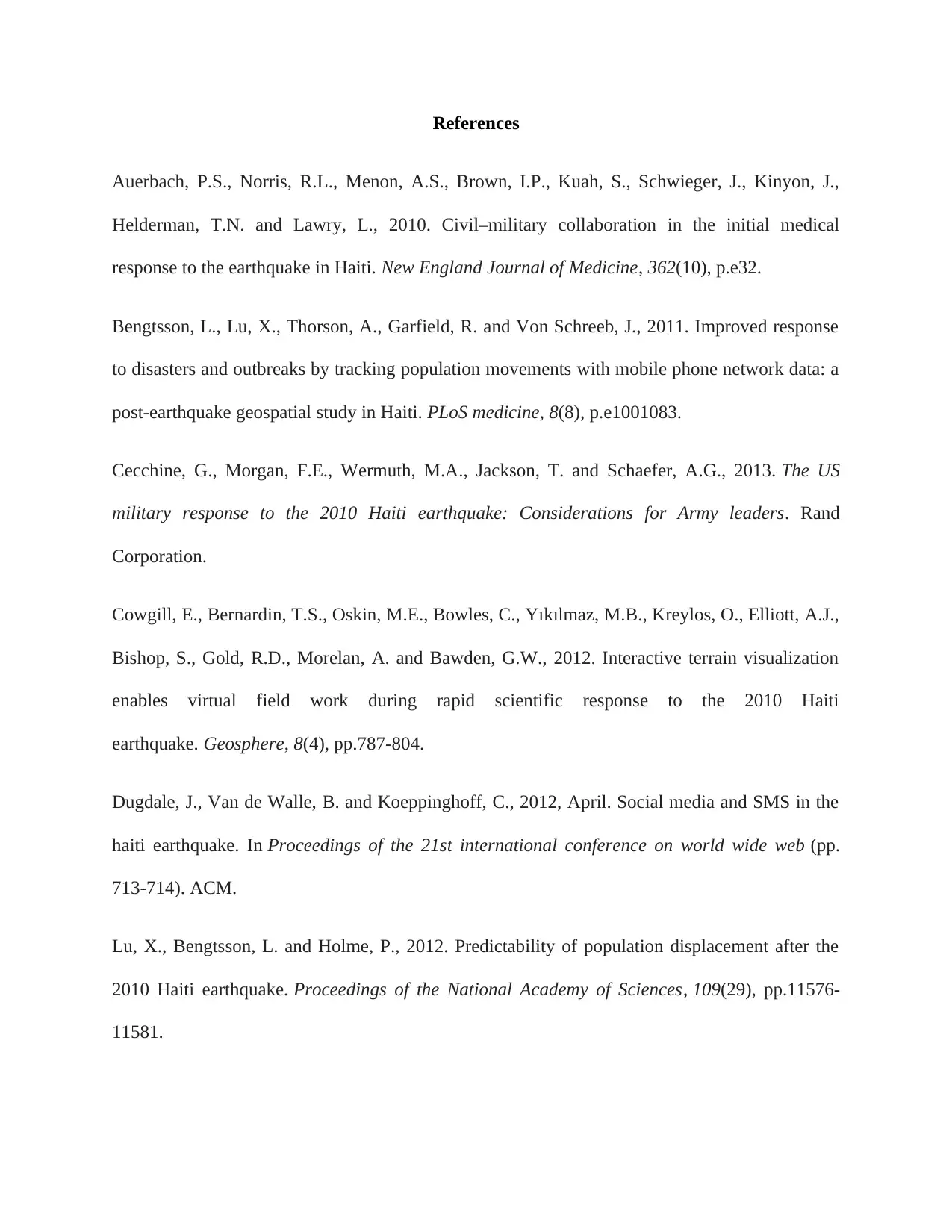
References
Auerbach, P.S., Norris, R.L., Menon, A.S., Brown, I.P., Kuah, S., Schwieger, J., Kinyon, J.,
Helderman, T.N. and Lawry, L., 2010. Civil–military collaboration in the initial medical
response to the earthquake in Haiti. New England Journal of Medicine, 362(10), p.e32.
Bengtsson, L., Lu, X., Thorson, A., Garfield, R. and Von Schreeb, J., 2011. Improved response
to disasters and outbreaks by tracking population movements with mobile phone network data: a
post-earthquake geospatial study in Haiti. PLoS medicine, 8(8), p.e1001083.
Cecchine, G., Morgan, F.E., Wermuth, M.A., Jackson, T. and Schaefer, A.G., 2013. The US
military response to the 2010 Haiti earthquake: Considerations for Army leaders. Rand
Corporation.
Cowgill, E., Bernardin, T.S., Oskin, M.E., Bowles, C., Yıkılmaz, M.B., Kreylos, O., Elliott, A.J.,
Bishop, S., Gold, R.D., Morelan, A. and Bawden, G.W., 2012. Interactive terrain visualization
enables virtual field work during rapid scientific response to the 2010 Haiti
earthquake. Geosphere, 8(4), pp.787-804.
Dugdale, J., Van de Walle, B. and Koeppinghoff, C., 2012, April. Social media and SMS in the
haiti earthquake. In Proceedings of the 21st international conference on world wide web (pp.
713-714). ACM.
Lu, X., Bengtsson, L. and Holme, P., 2012. Predictability of population displacement after the
2010 Haiti earthquake. Proceedings of the National Academy of Sciences, 109(29), pp.11576-
11581.
Auerbach, P.S., Norris, R.L., Menon, A.S., Brown, I.P., Kuah, S., Schwieger, J., Kinyon, J.,
Helderman, T.N. and Lawry, L., 2010. Civil–military collaboration in the initial medical
response to the earthquake in Haiti. New England Journal of Medicine, 362(10), p.e32.
Bengtsson, L., Lu, X., Thorson, A., Garfield, R. and Von Schreeb, J., 2011. Improved response
to disasters and outbreaks by tracking population movements with mobile phone network data: a
post-earthquake geospatial study in Haiti. PLoS medicine, 8(8), p.e1001083.
Cecchine, G., Morgan, F.E., Wermuth, M.A., Jackson, T. and Schaefer, A.G., 2013. The US
military response to the 2010 Haiti earthquake: Considerations for Army leaders. Rand
Corporation.
Cowgill, E., Bernardin, T.S., Oskin, M.E., Bowles, C., Yıkılmaz, M.B., Kreylos, O., Elliott, A.J.,
Bishop, S., Gold, R.D., Morelan, A. and Bawden, G.W., 2012. Interactive terrain visualization
enables virtual field work during rapid scientific response to the 2010 Haiti
earthquake. Geosphere, 8(4), pp.787-804.
Dugdale, J., Van de Walle, B. and Koeppinghoff, C., 2012, April. Social media and SMS in the
haiti earthquake. In Proceedings of the 21st international conference on world wide web (pp.
713-714). ACM.
Lu, X., Bengtsson, L. and Holme, P., 2012. Predictability of population displacement after the
2010 Haiti earthquake. Proceedings of the National Academy of Sciences, 109(29), pp.11576-
11581.
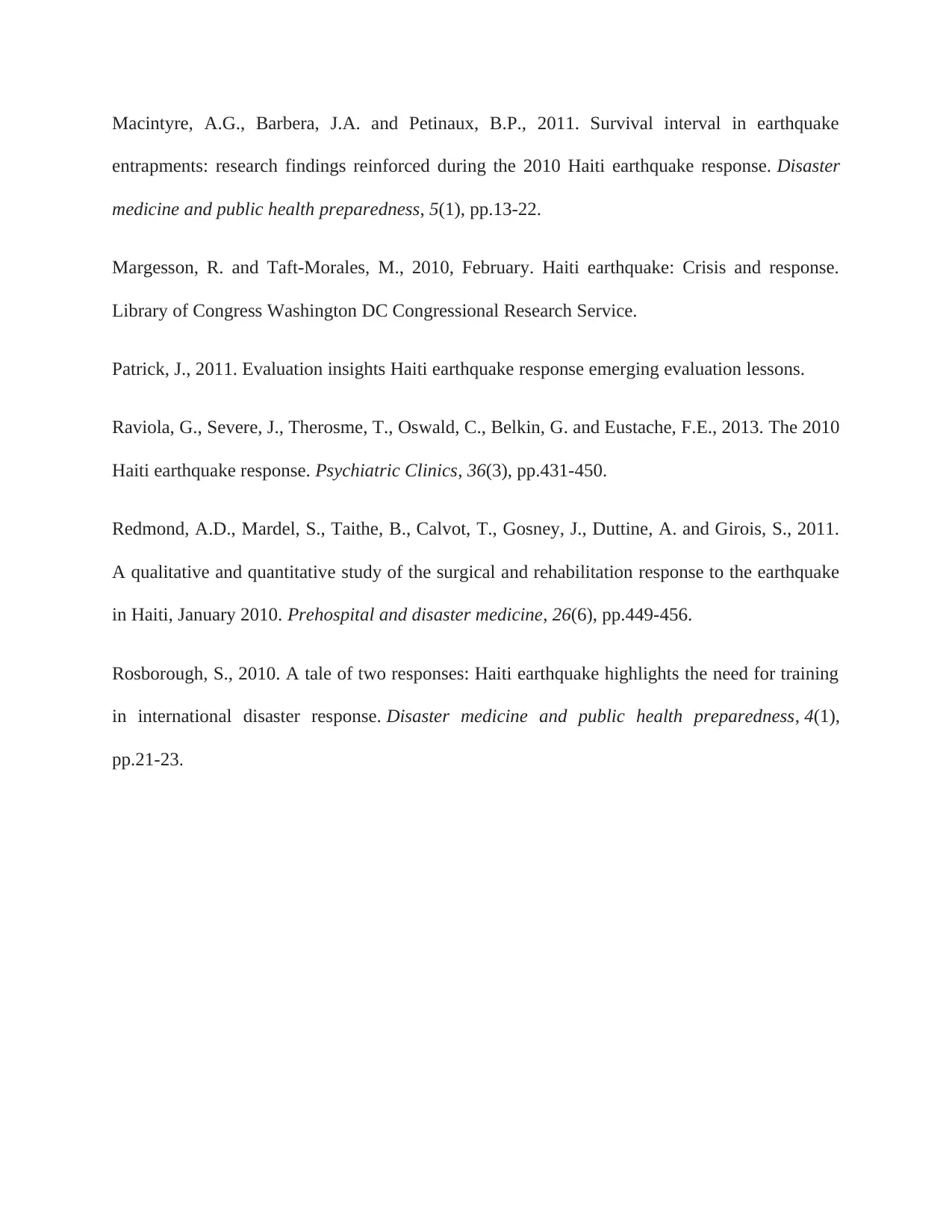
Macintyre, A.G., Barbera, J.A. and Petinaux, B.P., 2011. Survival interval in earthquake
entrapments: research findings reinforced during the 2010 Haiti earthquake response. Disaster
medicine and public health preparedness, 5(1), pp.13-22.
Margesson, R. and Taft-Morales, M., 2010, February. Haiti earthquake: Crisis and response.
Library of Congress Washington DC Congressional Research Service.
Patrick, J., 2011. Evaluation insights Haiti earthquake response emerging evaluation lessons.
Raviola, G., Severe, J., Therosme, T., Oswald, C., Belkin, G. and Eustache, F.E., 2013. The 2010
Haiti earthquake response. Psychiatric Clinics, 36(3), pp.431-450.
Redmond, A.D., Mardel, S., Taithe, B., Calvot, T., Gosney, J., Duttine, A. and Girois, S., 2011.
A qualitative and quantitative study of the surgical and rehabilitation response to the earthquake
in Haiti, January 2010. Prehospital and disaster medicine, 26(6), pp.449-456.
Rosborough, S., 2010. A tale of two responses: Haiti earthquake highlights the need for training
in international disaster response. Disaster medicine and public health preparedness, 4(1),
pp.21-23.
entrapments: research findings reinforced during the 2010 Haiti earthquake response. Disaster
medicine and public health preparedness, 5(1), pp.13-22.
Margesson, R. and Taft-Morales, M., 2010, February. Haiti earthquake: Crisis and response.
Library of Congress Washington DC Congressional Research Service.
Patrick, J., 2011. Evaluation insights Haiti earthquake response emerging evaluation lessons.
Raviola, G., Severe, J., Therosme, T., Oswald, C., Belkin, G. and Eustache, F.E., 2013. The 2010
Haiti earthquake response. Psychiatric Clinics, 36(3), pp.431-450.
Redmond, A.D., Mardel, S., Taithe, B., Calvot, T., Gosney, J., Duttine, A. and Girois, S., 2011.
A qualitative and quantitative study of the surgical and rehabilitation response to the earthquake
in Haiti, January 2010. Prehospital and disaster medicine, 26(6), pp.449-456.
Rosborough, S., 2010. A tale of two responses: Haiti earthquake highlights the need for training
in international disaster response. Disaster medicine and public health preparedness, 4(1),
pp.21-23.
1 out of 12
Your All-in-One AI-Powered Toolkit for Academic Success.
+13062052269
info@desklib.com
Available 24*7 on WhatsApp / Email
![[object Object]](/_next/static/media/star-bottom.7253800d.svg)
Unlock your academic potential
© 2024 | Zucol Services PVT LTD | All rights reserved.